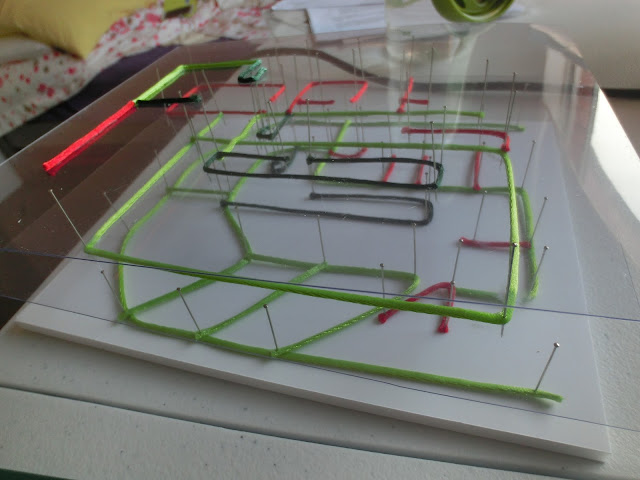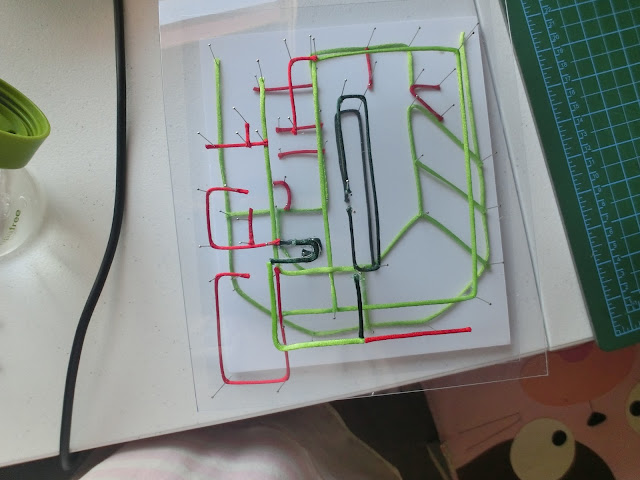First project
Part a
Week 2
Week 3
Week 4
Final
“This architectural promenade is in the ramp that extends between the floors from the lower level to the rooftop solarium and also mimicked in he spiral staircase that complements the ramp. This promenade creates a unique series of viewing moments as one rises through the structure. This prescribed routing allows those experiencing the space to experience it in a “series of partitions of infinite space.” The infinite space that one is seeing is bounded and defined by the structure and geometry of the building. Le Corbusier allows glimpses outward that allow the interior to flow out toward this infinite space.”
Circulation
Light green lines map open paths, dark green lines map central paths and red lines map closed paths.
The photos are about all the colours in this house. The colours from KT colour.
"The Villa Savoye is an early modernist masterpiece, examplifying Corbusier’s tenets of a new architecture. In part, this meant the exterior and interior walls were white (clean, new, pure, Modern) highlighted by planes of pure color. In his view, cool colors are calming and warm are stimulating (nothing new here) and that color in general is a strong modifier of mood. The pink wall in this photograph gives a center to the space and suggests intimacy and stimulating conversation. It also seems to bridge the gap between the warm coral pinks of William Morris and Art Nouveau, and the cooler, steely pinks and lilacs of Art Deco. The dark green around the exterior links the pure white of the building to the natural landscape; the blue next to the window stands purely as an accent. Note that it’s not the whole room or whole building that’s pink, but focused, prescise areas that direct how we conceive of and relate to living spaces."
http://www.apartmenttherapy.com/colortherapy-template-1-53028
Although an architectural purist, Le Corbusier was nevertheless a strong supporter of polychromy—the art of combining colors. ‘Man needs color. Color is the immediate, spontaneous expression of life.’ The exterior of Villa Savoye is predominantly white, but two side-walls of the garage and the servant quarters are painted dark green to create empathy with the surrounding lawn. Although of seemingly simple design, Villa Savoye proved to be extremely complex from a construction perspective. While Le Corbusier was experimenting with new concepts both on a functional and formal level, those contracted to build the house were still entrenched in traditional skills and techniques. This led to a series of disagreements, delays and cost overruns that would hamper the entire project.
"The Villa Savoye is an early modernist masterpiece, examplifying Corbusier’s tenets of a new architecture. In part, this meant the exterior and interior walls were white (clean, new, pure, Modern) highlighted by planes of pure color. In his view, cool colors are calming and warm are stimulating (nothing new here) and that color in general is a strong modifier of mood. The pink wall in this photograph gives a center to the space and suggests intimacy and stimulating conversation. It also seems to bridge the gap between the warm coral pinks of William Morris and Art Nouveau, and the cooler, steely pinks and lilacs of Art Deco. The dark green around the exterior links the pure white of the building to the natural landscape; the blue next to the window stands purely as an accent. Note that it’s not the whole room or whole building that’s pink, but focused, prescise areas that direct how we conceive of and relate to living spaces."
http://www.apartmenttherapy.com/colortherapy-template-1-53028
Although an architectural purist, Le Corbusier was nevertheless a strong supporter of polychromy—the art of combining colors. ‘Man needs color. Color is the immediate, spontaneous expression of life.’ The exterior of Villa Savoye is predominantly white, but two side-walls of the garage and the servant quarters are painted dark green to create empathy with the surrounding lawn. Although of seemingly simple design, Villa Savoye proved to be extremely complex from a construction perspective. While Le Corbusier was experimenting with new concepts both on a functional and formal level, those contracted to build the house were still entrenched in traditional skills and techniques. This led to a series of disagreements, delays and cost overruns that would hamper the entire project.































































